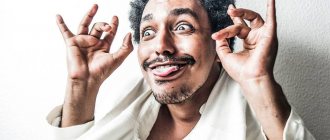Nadya Zima
Copywriter and journalist. Interests: fiction, culture and psychology.
From joy and euphoria to schadenfreude and bitterness, laughter can express the entire range of human emotions. If we try to control manifestations of anger consciously, then a sincere smile usually does not encounter psychological barriers and, appearing spontaneously on the face, becomes a clue to the personality.
The cheerfulness of a person is the most outstanding feature of a person, with legs and arms. It takes a long time to figure out a different character, but the person will laugh very sincerely, and his whole character will suddenly appear in full view. Only with the highest and happiest development can a person know how to have fun sociably, that is, irresistibly and good-naturedly.
F. M. Dostoevsky
"Teenager"
What is a good sense of humor
Let's start with the definition that Wikipedia gives us.
A sense of humor is a psychological feature thanks to which a person can notice contradictions in the world around him and evaluate them from a comic point of view.
Humor comes in different forms. There are many studies that have aimed to measure the level of humor and subject it to evaluation. This was done by disciplines such as sociology, linguistics, psychology, and anthropology. Some believe that humor serves to relieve tension and stress, while others argue that it is a physiological defense mechanism.
However, it is difficult to argue with the fact that humor is a very subjective thing. In addition to traditional “white” humor, there is also so-called black humor, which is often used within certain communities, for example, between doctors, police officers, criminals, etc.
When defining a good sense of humor, I would rely on the fact that it is primarily a feeling (from the word “feel”). That is, you need to feel where it’s funny and where it’s not at all. When can you joke, and when is it better to refrain from making jokes? Perhaps this is a good sense of humor.
In addition, an extremely important component of this quality is the ability to laugh at oneself. The ability to have a positive attitude towards yourself and those around you. Otherwise, it will no longer be a sense of humor, but causticity and prickliness.
Is wit good or bad?
If a person is witty, is that good or bad? Can we say that wit is a sign of intelligence? The answer is clear: being witty is commendable, but being clever is bad. Wit should be used when it is needed. This skill is not only a good quality, but also an indicator of originality and originality of thinking. Such a person certainly knows how to navigate different situations and at the same time understands the surrounding reality. Wit is often understood as the ability to think well and, literally, to grasp the most important things on the fly.
Is it possible to learn to joke
Yes, you can! It has long been proven that the human brain has neuroplasticity and is capable of change. We can gain new skills and even change our thinking, work on habits, beliefs, and character.
The structure of the brain changes when new neural connections are created or old ones break down. For example, when you learn a foreign language or learn to play the piano, you build new neural connections. If you do not use the acquired skills for a long time, these connections disintegrate and the skill is lost.
In fact, a person can learn any skill. The nuance is that some people find certain things easier and faster, while others find it more difficult to learn something. The reason lies in individual characteristics and personal experience.
For example, if you are 10 years old and have an ear for music, then learning to play a musical instrument will be easier for you than for an adult without an ear for music. Firstly, because in childhood the plasticity of the brain is higher and neural connections are built more easily, and secondly, an ear for music is still a natural given.
Same with a sense of humor. If you are naturally sociable and optimistic, you have a lot of friends and acquaintances, your family tends to joke and laugh, teasing and amusing each other, it probably wouldn’t even occur to you to search the Internet for information on how to develop a sense of humor.
Another question is if this style of communication was not accepted in the family, and the jokes of those around you always irritated you. It is logical that in this case you will have to work on your ability to joke. But the nice thing about the brain is that anything is possible. There would be a desire!
Learn about what a person's personality is and how individuality is manifested.
Causes of glossitis
- improper oral hygiene;
- bacterial infection;
- fungal infection;
- heavy metal poisoning;
- bad habits (smoking, alcoholism);
- congenital pathologies of the tongue (folded tongue);
- allergic reaction;
- tongue injury (often caused by malocclusion);
- oral infections;
- lack of iron in the body;
- burn of the mucous membrane (hot food or drinks);
- infectious diseases (AIDS, tuberculosis, scarlet fever, measles).
Mechanisms for constructing jokes
Before you can master something, you need to understand it. Let's see what humor is made of and what underlies it. Now I will tell you in simple words and with examples about the most different types of humor. Knowing the theory and reinforcing it with regular practice, you will definitely succeed.
Irony
This is a technique in which we say one thing and mean the opposite. For example, the object is ridiculed and exposed under the guise of praise.
When a colleague is very late and you say: “You are the king of punctuality today!”
Sketches from the “Our Russia” program were often based on irony. Remember? A brutal milling machine operator with an unconventional orientation, officials having fun in a jacuzzi and having high-profile conversations about the suffering of the people.
Irony can be different. Kinds:
- Simple. For example, tell a person who is afraid of something, they say, what a brave man you are.
- Self-irony. When a person laughs at himself. For example: “How can I, a fool, understand!”
- Anti-irony. The goal here is not to ridicule, but to show that someone was underestimated. For example, Zhvanetsky has the following lines: “The doctors did everything possible, but the patient still survived.”
More than 100 cool lessons, tests and exercises for brain development
Start developing
Ambiguity
The technique is also called word play. Here the humor is built around a specific word that has a double meaning. At the beginning of a joke it is used with one meaning, and at the end it takes on a different meaning.
Many jokes about Stirlitz are based on this:
- Stirlitz lit the stove all night. The next morning she drowned.
- It was blowing from the window. Stirlitz closed the window. The barrel disappeared.
Substitution of expectations
This technique is also often used in jokes.
A blind man walks into a bar with his guide dog. He is asked to leave as dogs are not allowed. He is indignant:
– This is my guide dog!
– Are you saying that this poodle is your guide dog?
- Lord, they gave me a poodle?!
When we hear the word “guide,” we imagine a Labrador or a retriever, but here we see a poodle, i.e., expectations are being broken.
Comparison of the incomparable
This technique is based on the fact that we compare things with each other that are far from each other in meaning and have nothing in common.
Life is like a piano: the key is white, the key is black... and the lid.
Jump
Here there is a listing of related or similar properties, and then a characteristic is inserted that does not fit into the context of what was previously said.
To be successful and rich, you need to run in the morning, read books on self-development, write down goals and... receive an inheritance from your uncle.
Friends, I would like to note that the above examples are not examples of how to joke correctly and properly. These are just illustrations of the designated types and techniques, so that you can imagine what traditional humor is based on. In fact, there are many such techniques. Each person may have their own.
Tips for developing a sense of humor
How to learn to notice humor and joke yourself? Let's see what recommendations comedians most often give to beginners:
- It all starts with thinking and attitude. Try to find positive moments in any failure or negative events, learn to laugh at yourself and treat jokes addressed to you kindly. And for this you need to become confident. Read how a man can develop confidence and how a woman can become confident.
- Hang out with people whose sense of humor you admire. Adopt experience, remember witticisms and the moments in which they were uttered. Also pay attention to the bad jokes of others, take them into account so as not to get into trouble yourself.
- Watch performances by stand-up comedians and interviews with comedians, read posts from bloggers with a good sense of humor and humorous literature, and take screenshots of interesting memes from social networks. You can keep a notebook and note down interesting techniques and expressions that you can use on occasion or come up with something of your own based on them. It will also be useful to analyze the jokes you hear and read, analyze why it makes you laugh, what techniques are used here, etc.
- Read more. This will help enrich your vocabulary. After all, it is he who allows you to turn any boring story into a colorful joke. And we have a separate publication about the benefits of reading.
- Learn the rules of the Russian language. Humor built around language errors is considered the most subtle and “not for everyone.” Only people who deeply understand the structure and logic of language constructs will understand such jokes. Here is a vivid example of such a mistake: “Driving past the station, my hat fell off.”
- Practice. Theory without practice is nothing. Don't be afraid to seem stupid and inappropriate at first. Remember that even the most popular comedian has his own personal style and limited audience. And even cool stand-up comedians do not always cause laughter in the audience. If it’s really difficult to get started, I recommend paying attention to public speaking courses, which will help improve the level of communication and improve the ability to make sparkling jokes for both girls and men.
Read about how to believe in yourself.
Exercises for every day
As I noted earlier, the art of telling jokes and funny stories is greatly influenced by the breadth of our vocabulary and flexibility of thinking. I will give several exercises that will help develop these aspects in both adults and children.
- Words starting with one letter
Choose a letter and make up several sentences where each word begins with it. It is important that the sentences are coherent and make sense.
- Three funny memories
Every day before going to bed, try to remember what funny or funny happened to you that day. Even if at first glance it seems that everything was ordinary, try to find humor even in simple or negative things.
This will help not only develop a humorous insight, but also teach you to cope with stress more easily and see the good even in the bad. By the way, we have a separate publication on our blog about how to solve any problems.
- Associations and anti-associations
Choose any word and match it with 10 similar in meaning, and then the same number that are opposite. Don't be too picky about the words you choose. “Chandelier” may well have “rug” as an anti-association, and the word “mountain” may have “hole.” This is a good way to exercise your brain and develop your imagination, which is very useful when creating jokes.
I recommend reading an article about how to develop imagination and imagination in children and adults.
- Pun
Think of a word with several meanings and make two sentences: the first with one meaning, and the second with a different meaning.
- Purpose of the item
Choose any object for the exercise and come up with as many uses for it as possible.
- Name of the picture
This workout can be done at any time, even scrolling through your social media feed. When you see a picture, try to come up with a name for it, but such that it does not make it clear what exactly is depicted. You can use irony and give names that are opposite in meaning.
- Hyperbola
Come up with joke titles that begin with the word “most.” For example: “The unluckiest conductor at the North Pole” or “The most gigantic garbage truck in the world”, etc. Then try to complete the joke by imagining what could happen if it were, for example, a stage miniature.
Burning mouth - treatment
The main goal is to eliminate the root cause found at the diagnostic stage. If it is not associated with dental pathology, the oral cavity is sanitized, worn fillings are removed and new fillings are placed, and dentures are corrected. Stomatitis and glossitis often require antibiotics. Candidiasis is treated with antifungal drugs.
General diseases are treated by a doctor of appropriate specialization, prescribing complex treatment depending on the type of pathology. Measures are being taken to improve immunity, normalize stomach function, stabilize blood glucose levels, and treat neuroses.
At home, you can alleviate the condition by rinsing your mouth with warm infusions of oak bark, sage, and chamomile. 1 tbsp is enough. per standard glass of water. Brew like tea, let cool and rinse your mouth 2-3 times a day. To prevent a burning sensation in the mouth, avoid or at least minimize spicy foods and caustic ingredients in your diet; it is better to avoid alcohol altogether.
Useful materials on the topic
If you want to dive deeper into the theory of humor and improve useful skills, I recommend reading the following books:
- Patrick King “How to be funny, witty and creative”
- Yuri Tamberg “How to develop a sense of humor”
- Elena Borscheva “How to catch humor by the tail”
Examples of humorous literature filled with funny jokes and humor:
- A. Bobkova, E. Pronina, N. Pigareva “Stroke, love, praise. A fun guide to raising a dog"
- Narine Abgaryan “Manyunya”
- Mikhail Zoshchenko “Humorous stories”
In addition, you can learn witty speech from someone who has already achieved great heights in humor. Pavel Volya certainly knows how to make good jokes. Right now there is a course on Humor in the public domain on his website. To receive lessons, you need to register by entering your email and name.
The program is free. It consists of 18 lessons and contains theory in the form of text and videos and practical tasks that need to be completed online.











